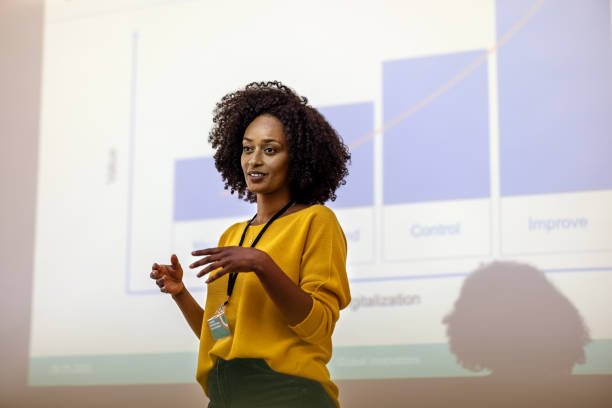Find all Presentation and Data Response Notes, Examination Guide Scope, Lessons, Activities and Questions and Answers for Business Studies Grade 12. Learners will be able to learn, as well as practicing answering common exam questions through interactive content, including questions and answers (quizzes).
Topics under Presentation and Data Response
- Preparation of a Successful Presentation
- Using Visual Aids
- Verbal and Non-verbal Information
Presentations are an important aspect of business studies as they provide an opportunity for learners to showcase their knowledge and skills to an audience. Whether it’s a data response or a multimedia presentation, it’s essential to prepare effectively to ensure that the presentation is professional, engaging, and informative. We’ll guide grade 12 business studies learners on how to prepare for presentation and data response topics.
Factors to Consider When Preparing for a Presentation
- Purpose of the Presentation: Understanding the purpose of the presentation is crucial in determining the content and structure of the presentation. This will help you tailor your presentation to meet the needs and interests of your audience.
- Content: When preparing for a presentation, it’s important to gather information from a variety of sources, including textbooks, online resources, and other relevant materials. Ensure that the content is accurate, relevant, and concise.
- Structure: Developing a clear and organized structure for your presentation will make it easier for you to present the information and for the audience to follow along. Start with an introduction, then move on to the main points, and conclude with a summary.
- Timing: Allocating enough time for each section of the presentation is crucial in ensuring that the presentation runs smoothly. Avoid rushing through the content and allow enough time for questions and feedback.
Factors to Consider While Presenting
- Eye Contact: Maintaining eye contact with the audience is important in building a connection and keeping the audience engaged. It shows that you are confident and that you value the audience’s attention.
- Visual Aids: Using visual aids effectively can help to reinforce the information you are presenting and make the presentation more engaging. Ensure that the visual aids are clear, relevant, and easy to understand.
- Movement: Moving around the room can help to break up the monotony of the presentation and keep the audience interested. However, avoid excessive movement as it can be distracting.
- Pacing: Speak clearly and at a moderate pace. Avoid speaking too fast or too slow, as this can make it difficult for the audience to follow along. Use pauses effectively to emphasize important points.
Responding to Questions and Feedback
- Responding to Questions: It’s important to be prepared for questions from the audience. Answer the questions clearly and concisely, and if you don’t know the answer, be honest and say so.
- Handling Feedback: Feedback can be valuable in helping you to improve your presentation skills. Listen to the feedback objectively and avoid taking it personally. Respond to feedback in a non-aggressive and professional manner, and thank the person for their input.
Identifying Areas for Improvement
- Self-Reflection: Take some time after the presentation to reflect on your performance. Consider what you did well and what you could have done better.
- Feedback: Ask for feedback from your peers, classmates, or teacher. This can provide valuable insights into areas for improvement and help you to become a better presenter.
Recommendations for Future Improvements
- Practice: Practice makes perfect, so it’s important to practice your presentation several times before delivering it to the audience.
- Seek Feedback: Regularly seek feedback from others to help you identify areas for improvement and refine your presentation skills.
- Use Visual Aids Effectively: Consider how you can use visual aids more effectively in future presentations, such as incorporating more graphs or images to reinforce the information being presented.
Non-Verbal Presentations
- Written Reports: Written reports are a type of non-verbal presentation that can be used to provide detailed information and analysis on a particular topic. They are a useful tool for presenting information that cannot be easily conveyed through verbal or visual means.
- Scenarios: Scenarios are a type of non-verbal presentation that use hypothetical situations to illustrate concepts or theories. They can be used to demonstrate the potential outcomes of a particular decision or action.
- Graphs: Graphs, such as line, pie, and bar charts, are a useful tool for presenting data in a visual manner. They can help to illustrate trends, patterns, and relationships between different variables.
- Pictures and Photographs: Pictures and photographs can be used to enhance the visual appeal of a presentation and to provide context for the information being presented.
Designing a Multimedia Presentation
- Start with the Text: Start by developing the text for your presentation, ensuring that it is clear, concise, and relevant to the topic.
- Select the Background: Choose a background that is simple and not distracting. Ensure that the background complements the text and images used in the presentation.
- Choose Relevant Images/Create Graphs: Select images and create graphs that reinforce the information being presented and help to illustrate key points.
- Incorporate Visual Aids: Incorporate visual aids, such as graphs, images, and videos, into the presentation to make it more engaging and informative.
The Effectiveness of Visual Aids
Visual aids, such as graphs, images, and videos, can be effective in reinforcing the information being presented and making the presentation more engaging. However, they can also be distracting if they are not used effectively. It’s important to consider the advantages and disadvantages of visual aids when preparing a presentation, and to use them in a manner that supports the content and purpose of the presentation.
Preparing for a presentation in business studies requires careful planning and attention to detail. By considering the factors discussed in this article, grade 12 business studies learners can improve their presentation skills and deliver effective and engaging presentations.

